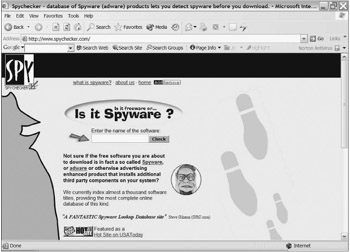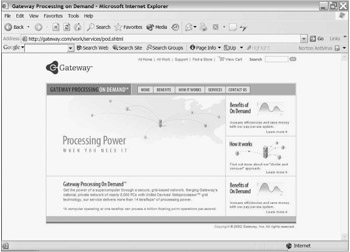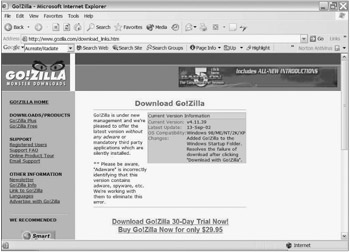Spyware
Now think of Ghostfiles in a different context. Imagine if your every keystroke was mirrored without your knowledge and routed to somebody else's server. That's how a "keylogger," one variety of spyware, works. Spyware is technology installed clandestinely on a computer for the express purpose of surveillance. Who installs it? Nosy bosses, suspicious spouses, anxious parents, but more often than not, we unwittingly install it ourselves . Spyware, and its first cousin, adware, piggyback on many freely available programs on the Internet unbeknownst to the downloader. Once installed, adware traces a user 's activities and reports them to a database network generally operated by a marketing company. Spyware reports the prey's activities back to who installed it in the first place. Spyware is the digital equivalent of trespassing on personal property, technology that can track you and commandeer your computer. Several software firms have developed applications to combat spyware, while others put their faith in pending legislation to ban it. In the meantime, spyware and adware are surreptitiously installed on the hard drives of millions of unsuspecting computer users! Spychecker.com (http://www.spychecker.com), a popular Web site, lists in its database more than a thousand programs that currently install spyware. The next time you think about downloading software, search Spychecker.com first. You'll find a link on the Invasion of Privacy homepage at http://www.mjweber.com/iop/privacy.htm

Figure 6.2: Spychecker.com Web site
The Symptoms of Spyware
Your computer boots slower than usual and weird things happen with your Web browser. Suddenly, you're redirected to unfamiliar Web sites for no apparent reason. Your browser freezes , and Windows crashes! When you finally get to the bottom of it, if you ever do, you discover that some wacko has been tracking your every keystroke for weeks! It turns out your computer has been acting funny because a network of researchers has been hogging your CPU's clock-cycles to document the relationship between biorhythms and crop circles. This is known as grid computing, the utilization of CPU cycles from hundreds of individual computers networked to form a virtual supercomputer. To add insult to injury , when the smoke clears you learn your teenage son is totally to blame. Apparently, he inadvertently gave the grid network permission to use your computer for research when he downloaded a hot new game demo embedded with spyware! Grid computing is nothing new, but it's come back into vogue with the advent of broadband and multi-gigabyte CPUs. Gateway, the PC manufacturer, recently harnessed the power of 8,000 demo computers located throughout its 270 retail branches to form a new processor grid. Gateway claims their 8,000-computer grid can operate at more than 14 TFLOPs (teraflops), processing power equivalent to that of the second fastest supercomputer on the planet. Gateway offers Processing On Demand for oil reservoir modeling, gene sequencing, pharmaceutical research, insurance risk assessment models, and crash test simulations. Whatever became of that nice spotted cow?

Figure 6.3: Gateway Processing On Demand site
The Aureate/Radiate Go!Zilla Fiasco
The most rampant example of spyware I know of is Go!Zilla. Introduced a few years ago, Go!Zilla became the Internet's premier download manager. Millions of users downloaded it...that is, until word spread that the program installed secret DLLs ( Dynamic Link Libraries ) embedded by spyware giant Aureate/Radiate that tracked the surfing habits and download preferences of its users. Aureate ”which later changed its name to Radiate because no one could pronounce it, or to remain elusive , or both ”was installed on more than 30 million PCs worldwide, and it is still being installed with shocking regularity. More than 500 "advertising supported" programs currently install it. And it's nearly impossible to find Aureate/Radiate on the Internet unless you know where to look. A search on Google for "Aureate/Radiate" returns thousands of links to remove the spyware, but not one link to the company's Web site!

Figure 6.4: Aureate/Radiate Google search results

Figure 6.5: Go!Zilla disclaimer
Because of its tarnished reputation, Go!Zilla is under new management and claims version 4.11.39 is "free of any adware or mandatory third party applications which are silently installed."
However, buried within Go!Zilla's privacy policy is this little tidbit:
-
Traffic Analysis: A software program is used to analyze traffic to this web site. This software does not create individual profiles for visitors . Unlike some tracking software, our software does not have a database of individual profiles for each visitor. Our software program collects only aggregate data.
As soon as I read this, I closed my Web browser and did a search for any new Aureate/Radiate components on my hard drive. If you want a download manager that doesn't contain spyware, I highly recommend SpeedBit's free Download Accelerator Plus, which has more than 50 million registered users.
A stable OS ( Operating System ) is a terrible thing to waste! Part II, "Zone Defense," includes detailed instructions on spyware removal and creating restore points in Windows XP and ME. Whenever I install new software, I always take these precautionary steps:
-
Find out whether the program is listed in the Spychecker.com database.
-
Create a Windows restore point before installing any new software.
-
Scan any new program with antivirus software before launching.
-
Scan the hard drive with Ad-aware or Spybot before launching.

Figure 6.6: Ad-aware screen
EAN: 2147483647
Pages: 135